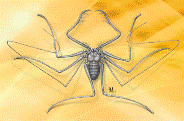Papers in the Biological Sciences

Eileen Hebets Publications
Document Type
Article
Date of this Version
8-2015
Citation
Published in Animal Behaviour 108 (2015), pp. 25–32. doi 10.1016/j.anbehav.2015.07.001
Abstract
Nocturnal animals frequently possess seemingly conspicuous color patterns that can function in a variety of ways (e.g. prey attraction, camouflage, predator avoidance, etc.). The use of color patterns in intraspecific signaling, especially reproductive activities, in nocturnal animals has received relatively little attention. This study tested for a dual function of color in the nocturnal fishing spider, Dolomedes raptor (Araneae: Pisauridae), whose males develop dimorphic white stripes at sexual maturation. We tested for a role in foraging as well as mate assessment. First, quantifications of the natural variation of male stripes indicated a correlation between stripe area and male body size and weight. Subsequent diet experiments confirmed that the area of a male’s white stripes are body size-dependent and thus could potentially convey information to choosey females about male quality. Field experiments used dummies resembling D. raptor in appearance to test a prey attraction function of the white stripes. We found that dummies with the white stripes present attracted significantly more prey than those without stripes. Finally, we used males with manipulated phenotypes in laboratory mating trials and found that males with intact white stripes were significantly more likely to be accepted by females than those with the white stripes eliminated. Together, our results document a nutrient-dependent trait that functions not only in strengthening foraging success, but also in a mating context, increasing male mating success. We suggest that the role of these male white stripes in reproduction has been facilitated by their function in foraging.
Included in
Animal Sciences Commons, Behavior and Ethology Commons, Biology Commons, Entomology Commons, Genetics and Genomics Commons


Comments
Copyright © 2015 The Association for the Study of Animal Behaviour. Published by Elsevier Ltd. Used by permission.